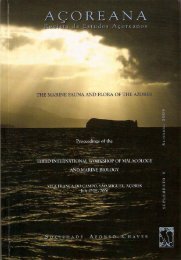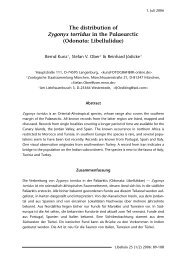On the taxonomy and natural history of Oxypoda brachyptera and O ...
On the taxonomy and natural history of Oxypoda brachyptera and O ...
On the taxonomy and natural history of Oxypoda brachyptera and O ...
You also want an ePaper? Increase the reach of your titles
YUMPU automatically turns print PDFs into web optimized ePapers that Google loves.
Beitr. Ent. 62 (2012) 1<br />
In some study sites, especially Heiliger Hain <strong>and</strong> Schneverdingen, O. <strong>brachyptera</strong> was among <strong>the</strong><br />
most abundant staphylinid species in <strong>the</strong> pitfall traps, despite its small body size. As can be seen<br />
in Fig. 26, <strong>the</strong> pooled seasonal densities are relatively low. They are highest in spring <strong>and</strong> range<br />
between less than one to approximately 4.5 individuals per square meter. Thus, it can be concluded<br />
that, in comparison to o<strong>the</strong>r staphylinids <strong>of</strong> similar <strong>and</strong> even larger body size, <strong>the</strong> epigeic activity<br />
<strong>of</strong> O. <strong>brachyptera</strong> from April through August is enormous. The sex ratio (males:females) in <strong>the</strong><br />
soil samples was 0.62, whereas in <strong>the</strong> pitfall traps it was 1.24, suggesting that <strong>the</strong> epigeic activity<br />
<strong>of</strong> males is distinctly greater than that <strong>of</strong> females. This particularly applies to <strong>the</strong> period from <strong>the</strong><br />
second half <strong>of</strong> April through <strong>the</strong> first half <strong>of</strong> August, during which time <strong>the</strong> proportions <strong>of</strong> males<br />
in <strong>the</strong> pitfall traps ranged between 55.5 <strong>and</strong> 61.6 %.<br />
As can be inferred from <strong>the</strong> data shown in Fig. 27, O. <strong>brachyptera</strong> apparently has two generations<br />
per year. Oviposition takes place from <strong>the</strong> second half <strong>of</strong> March to <strong>the</strong> second half <strong>of</strong> September.<br />
However, <strong>the</strong>re are two maxima, one from mid-April to mid-May <strong>and</strong> one from Mid-June to<br />
mid-August. Emergence from <strong>the</strong> pupa occurs from <strong>the</strong> beginning <strong>of</strong> May to <strong>the</strong> first half <strong>of</strong><br />
December, again with two maxima. The first one is from <strong>the</strong> beginning <strong>of</strong> June to mid-July <strong>and</strong><br />
<strong>the</strong> second one in <strong>the</strong> second half <strong>of</strong> August. A comparison <strong>of</strong> <strong>the</strong> two curves in Fig. 27 suggests<br />
that pre-imaginal development from oviposition to emergence from <strong>the</strong> pupa lasts approximately<br />
1.5-2 months <strong>and</strong> that hibernation occurs in <strong>the</strong> adult stage. There appears to be no aestivation<br />
period or diapause.<br />
<strong>On</strong> one occasion (Hannover, August), one dissected female was found to be infested with<br />
nematodes.<br />
Fig. 25: Pooled seasonal activity density <strong>of</strong> O. <strong>brachyptera</strong> based on pitfall trap studies in 20 study plots in<br />
Niedersachsen during <strong>the</strong> period from 1981 to 2001 (total: 7110 specimens). The months are given in halfmonthly<br />
intervals (F1 = first half <strong>of</strong> February, F2 = second half <strong>of</strong> February, etc.).<br />
217
















